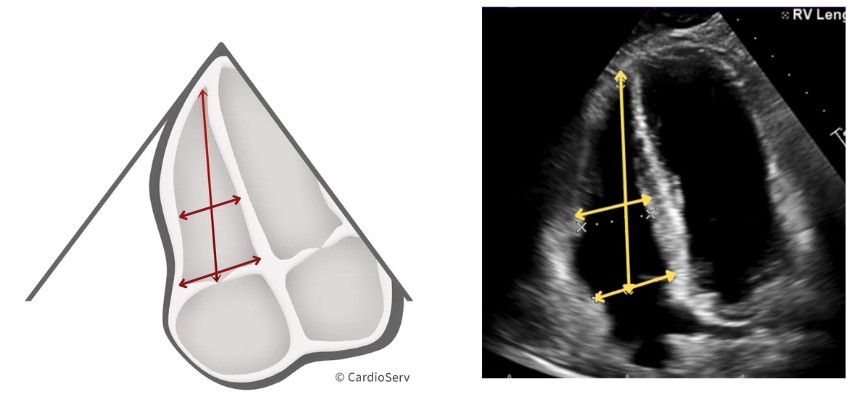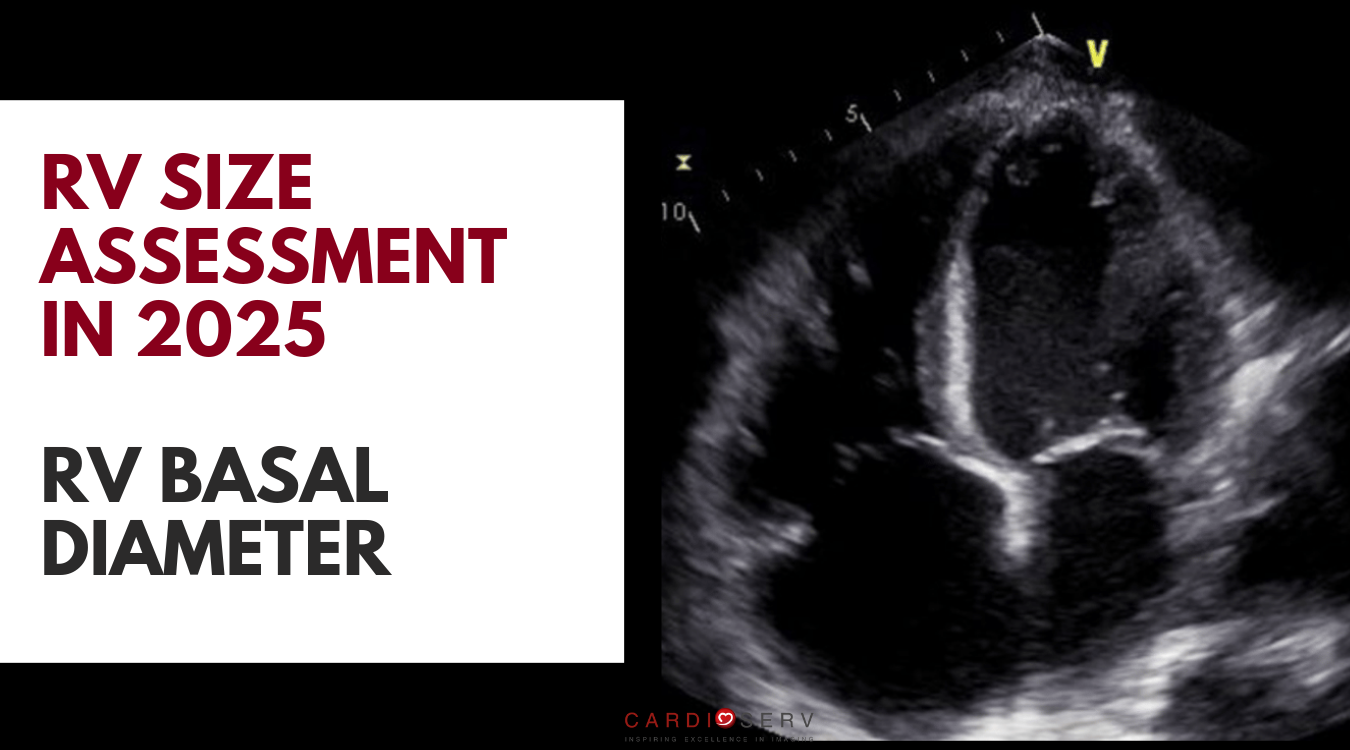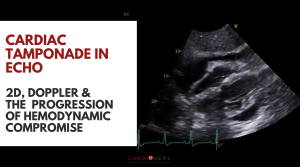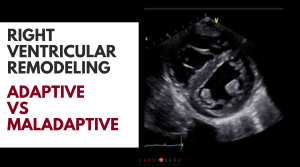Last Updated on November 18, 2025 by Don Gerig, RDCS
Right ventricular (RV) size is one of the most important components of right heart assessment. Yet in many echo labs, RV size and function are still often reported by visual estimation alone, an approach that’s both subjective and inconsistent.
Over the years, ASE guidelines have provided a better approach by shifting from visual estimation to quantitative measurement cutoffs. Now, the 2025 ASE Right Heart Guidelines take it a step further by introducing graded severity ranges for RV linear dimensions providing clearer, more standardized reporting of right ventricular size.
While linear measurements can be used to evaluate RV size from both the parasternal and apical windows, the updated standards emphasize the RV-focused apical four-chamber view, where the RV basal diameter serves as the reference for new severity grading.
In this article, we’ll focus specifically on the RV basal diameter measurement, explore the new severity grading, and discuss the prognostic value of this updated approach to evaluating RV size.
For a deeper dive into RV size assessment, check out these resources:
A Brief History of RV Basal Diameter in the Guidelines
2010 ASE Right Heart Guidelines
RV basal diameter was formally standardized for the first time, with >4.1 cm indicating enlargement. Before this, RV size was often described qualitatively (“normal” or “dilated”) without consistency. The 2010 update introduced objective cutoffs, laying the foundation for future standardized quantification, though graded severity (mild, moderate, severe) was not yet defined.
2015 ASE Chamber Quantification Guidelines
The 4.1 cm upper limit was reaffirmed and placed within a broader framework for right-heart evaluation. The update encouraged integration of RV mid-cavity and longitudinal dimensions, FAC, and 3D volumes, marking a shift from simple “normal or enlarged” reporting to a more comprehensive, geometric approach.
2025 ASE Right Heart Guidelines
The 4.1 cm cutoff remains, but new graded severity ranges (mild, moderate, severe) now bring clarity and consistency to RV size reporting. RV basal diameter is no longer viewed in isolation, it’s interpreted alongside 3D volumes, mid and longitudinal dimensions, and RV–PA coupling indices, reflecting ASE’s integrated approach to right-heart structure and function.
What’s New in 2025: Graded Severity Cutoffs
For years, right ventricular (RV) enlargement was described as either “normal” or “dilated,” offering little nuance for clinical interpretation. The 2025 ASE Right Heart Guidelines change that by introducing graded severity categories for RV basal diameter—a major step toward more consistent and meaningful reporting.
These new ranges help clinicians distinguish between mild, moderate, and severe RV enlargement, improving prognostic accuracy and standardization across labs. The cutoffs are as follows:
RV Basal Diameter Graded Severity Ranges

This move from a single cutoff to graded severity makes RV size assessment more clinically meaningful, particularly in pulmonary hypertension and right heart failure.
Why Graded RV Basal Diameter Improves Prognostic Value
Reflects the Full Spectrum of RV Remodeling
The right ventricle adapts before it fails. Grading basal diameter (mild, moderate, severe) captures this progression from compensation to decompensation, something a simple “normal vs. enlarged” label misses.
Adds Prognostic Power Beyond Function
Size and function tell different stories. Basal diameter shows how far the RV has remodeled, often before functional decline appears. In pulmonary hypertension, the RV basal diameter index predicts clinical worsening independently of functional parameters.
Improves Risk Stratification and Clinical Decisions
Grading allows clinicians to identify which patients need closer monitoring or earlier intervention. “Moderate enlargement” carries different implications than simply “enlarged.”
Aligns with the 2025 ASE Right Heart Framework
The new ASE guidelines integrate structure, function, and hemodynamics. Graded RV size fits into this multiparametric model, alongside TAPSE, FAC, RV strain, and RV–PA coupling, to provide a clearer picture of remodeling and prognosis.
Detects Early Change Before Dysfunction
RV dilation often appears before systolic failure. Graded measurement helps identify these early “compensated” changes, guiding earlier, proactive management.
How to Measure RV Basal Diameter
Accurate measurement of the RV basal diameter begins with image acquisition. A proper RV-focused apical four-chamber view is essential to avoid foreshortening and to ensure the true maximal dimension of the right ventricle.
- Obtain an RV-focused apical four-chamber view, adjusting the transducer to center the RV and elongate the apex
- Measure at end-diastole
- Inner edge to inner edge
- Avoid foreshortening of the RV apex
- Use ultrasound-enhancing agents when endocardial definition is suboptimal

Remember to report RV size with at least one quantitative measurement. In most cases, this measurement will be the basal diameter from the RV-focused apical 4-chamber view. When possible, supplement with mid-cavity and longitudinal dimensions or 3D volumes for a more complete assessment.
Frequently Asked Questions
According to the 2025 ASE Right Heart Guidelines, a normal RV basal diameter is less than 4.1 cm in the apical four-chamber view. The new guidelines also introduce graded severity ranges to describe RV enlargement:
Mild: 4.1–4.4 cm
Moderate: >4.4–4.9 cm
Severe: >4.9 cm
The latest update moves beyond a single “normal vs. enlarged” cutoff. It now provides graded severity categories for basal diameter and emphasizes integrating linear measurements with volumetric measurements, FAC, TAPSE, and strain for a comprehensive evaluation.
RV basal diameter offers a reproducible, quantitative measure of right-ventricular size. When used alongside other parameters, it helps identify early remodeling, improves prognostic accuracy, and supports consistent reporting across echo labs.
Final Thoughts and Next Steps
The 2025 ASE Right Heart Guidelines represent a major leap forward in how we quantify and communicate right ventricular size. By introducing graded severity ranges for RV basal diameter, ASE moves beyond simple “normal vs. enlarged” terminology, providing a more precise, standardized, and clinically meaningful approach to right-heart assessment.
Go Even Deeper!
Right Heart Quantification: RV & RA Size
Review the latest guidelines for correct echocardiographic quantification of the right heart. Learn tips and techniques to properly measure the size of the right ventricle and atrium using both linear and volumetric methods.
- ✔ Acquire and measure RV basal diameter using ASE 2025 standards
- ✔ Apply graded severity categories in daily reporting
- ✔ Integrate RV and RA size with other right-heart indices
- ✔ Avoid common pitfalls and improve reporting consistency






